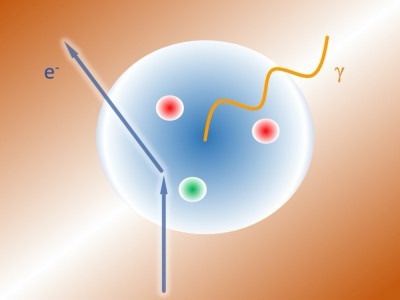Reviewed by Alex SmithOct 20 2022
Nuclear physicists have corroborated that the existing explanation of proton structure is not perfect. A recent accuracy determination of the proton’s electric polarizability conducted at the U.S. Department of Energy’s Thomas Jefferson National Accelerator Facility has exposed a gap in the data in probes of the proton’s structure.
 The real photon that is produced in the virtual Compton scattering reaction provides the electromagnetic perturbation to the proton and allows to measure its electromagnetic generalized polarizabilities. Image Credit: Nikos Sparveris, Temple University.
The real photon that is produced in the virtual Compton scattering reaction provides the electromagnetic perturbation to the proton and allows to measure its electromagnetic generalized polarizabilities. Image Credit: Nikos Sparveris, Temple University.
Though extensively believed to be a coincidence when observed in earlier measurements, this new, more precise measurement has corroborated the anomaly's existence and raises doubts concerning its source. The study has recently been published in the journal Nature.
According to Ruonan Li, the study’s first author and a graduate student at Temple University, measurements of the proton’s electric polarizability expose how vulnerable the proton is to distortion, or stretching, in an electric field. Like charge or size, electric polarizability is a central property of proton structure.
Furthermore, a precision measurement of the proton’s electric polarizability can help connect the various explanations of the proton. Based on how it is probed, a proton may look like an opaque single particle or a composite particle composed of three quarks adhered together by a strong force.
We want to understand the substructure of the proton. And we can imagine it like a model with the three balanced quarks in the middle. Now, put the proton in the electric field. The quarks have positive or negative charges. They will move in opposite directions. So, the electric polarizability reflects how easily the proton will be distorted by the electric field.
Ruonan Li, Study First Author and Graduate Student, Temple University
To examine this distortion, nuclear physicists used a method known as virtual Compton scattering. It begins with a cautiously regulated beam of energetic electrons from Jefferson Lab’s Continuous Electron Beam Accelerator Facility, a DOE Office of Science user facility. The electrons are sent hurtling into protons.
In the virtual Compton scattering method, electrons interact with other particles by releasing an energetic photon, or particle of light. The electron's energy establishes the energy of the photon it releases, which also establishes how the photon relates to other particles.
Lower energy photons may deflect off the proton’s surface, while more energetic photons will explode within the proton to interact with one of its quarks. Theory estimates that when these photon-quark interactions are strategized from lower to higher energies, they will develop a smooth curve.
Nikos Sparveris, an associate professor of physics at Temple University and the experiment’s spokesperson, said this basic picture did not pass the scrutiny test. The measurements exposed an as-yet-inexplicable bump.
What we see is that there is some local enhancement to the magnitude of the polarizability. The polarizability decreases as the energy increases as expected. And, at some point, it appears to be coming temporarily up again before it will go down.
Nikos Sparveris, Associate Professor, Physics, Temple University
“Based on our current theoretical understanding, it should follow a very simple behavior. We see something that deviates from this simple behavior. And this is the fact that is puzzling us at the moment,” Sparveris added.
The theory estimates that the more energetic electrons are more directly probing the powerful force as it adheres the quarks together to form the proton. This strange spike in the stiffness that nuclear physicists have currently established in the quarks signals of a proton that an unidentified facet of the powerful force may be at play.
There is something that we’re clearly missing at this point. The proton is the only composite building block in nature that is stable. So, if we are missing something fundamental there, it has implications or consequences for all of physics.
Nikos Sparveris, Associate Professor, Physics, Temple University
The physicists stated that the following step is to further extract the details of this irregularity and perform precision probes to verify other points of deviation and to offer more information about the irregularity’s source.
“We want to measure more points at various energies to present a clearer picture and to see if there is any further structure there,” Li said.
Sparveris concurred.
“We also need to measure precisely the shape of this enhancement. The shape is important to further elucidating the theory,” he concluded.
Journal Reference:
Li, R., et al. (2022) Measured proton electromagnetic structure deviates from theoretical predictions. Nature. doi.org/10.1038/s41586-022-05248-1.